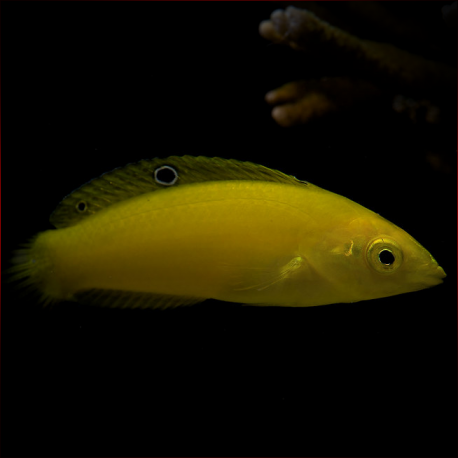More info
Datasheet
| Minimum Tank Size | 400 litres / 105.67 US gallons |
| Maximum Size | 14.0cm / 5.51inches |
| Reef Compatible | Always reef safe |
| Temperament | Mostly peaceful but might be aggressive towards similar species |
| Temperature | 22.2°C / 71.96°F - 25.6°C / 78.08°F |
| Specific Gravity | 1.020-1.025 |
| Carbonate Hardness | 8-12 |
| pH | 8.1-8.4 |
General Description
The Yellow Wrasse, scientifically known as Halichoeres chrysus, is a vibrant species categorized under the Labridae family. These fish are highly sought after in aquariums for their beauty and their effectiveness in eliminating flatworms and pyramid snails. They are generally more peaceful compared to other similar species but can outgrow smaller tank sizes over time. Yellow Wrasses have unique feeding habits, with some subsisting on small invertebrates while others can crush various crustaceans. They display interesting behavior by burying themselves in the sand when threatened or in need of rest.
Aquarium Suitability
With proper care, Yellow Wrasses are deemed suitable for aquariums. They are known to be hardy and have specific requirements such as a deep sandy substrate to facilitate their natural behavior of burrowing. These wrasses tend to do well when kept as a pair, usually consisting of one male and one female, or with a single male accompanied by multiple females.
Care and Hardiness
Yellow Wrasses are considered hardy fish; however, they are known to be sensitive during transportation and acclimatization to a new tank. When selecting individuals at the store, it's essential to ensure they are not injured, particularly around the mouth area. After transport, it may take some time for their biological clock to readjust fully.
Reef Suitability
These wrasses are deemed reef-safe, making them a good choice for reef aquariums. They are compatible with various reef setups and can coexist peacefully within the reef environment.
Aquarium Setup
To cater to their needs, an aquarium housing Yellow Wrasses should have a minimum capacity of 400 liters. The tank should provide a deep sandy substrate of at least 2 inches to allow the wrasses to burrow when necessary. Maintaining stable water conditions with ideal parameters for pH, temperature, salinity, and carbonate hardness is crucial for their well-being.
Behaviour
Yellow Wrasses exhibit mostly peaceful behavior but can show aggression towards similar species. They have a unique habit of smashing larger prey against rocks and burying themselves in the sand when threatened. Additionally, they are known to jump out of open aquariums, necessitating the need for a secure lid.
Feeding and Diet
Their diet mainly consists of small crustaceans like krill, mysis, and artemia, along with zooplankton such as Cyclops and pods. Yellow Wrasses are opportunistic feeders and may also feed on flatworms and pyramid snails, aiding in pest control within the aquarium.
Dimorphism and Captive Reproduction
Yellow Wrasses are hermaphroditic, with the capability of changing gender from female to male as needed. In a group setting, they function best as a pair or in a harem structure. Captive reproduction of these wrasses can be achieved with proper tank conditions and compatible tank mates.
Habitat and Distribution
Native to the Eastern Indian Ocean, specifically Christmas Island, and the Western Pacific region from the Solomon Islands to southern Japan and New South Wales in Australia, the Yellow Wrasses have a wide distribution. Recently, sightings have been reported in Tonga, further expanding their known habitat range.

